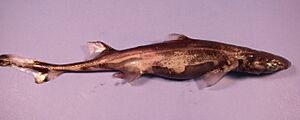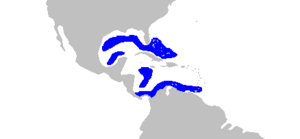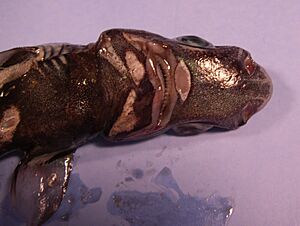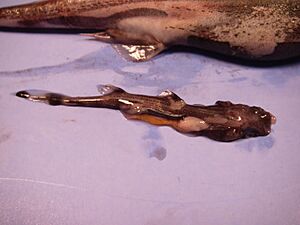Green lanternshark facts for kids
Quick facts for kids Green lanternshark |
|
|---|---|
 |
|
| Conservation status | |
| Scientific classification | |
| Genus: |
Etmopterus
|
| Species: |
virens
|
 |
|
| Range of the green lanternshark | |
The green lanternshark (Etmopterus virens) is a small dogfish shark. It belongs to the family Etmopteridae. You can find this shark in the western central Atlantic Ocean. It usually lives deep in the ocean, on the upper part of the continental slope. This is typically below a depth of 350 meters (about 1,150 feet).
Green lanternsharks are quite small, growing up to 26 centimeters (about 10 inches) long. They have a thin body with a long, narrow tail. Their skin has small, cone-shaped bumps called dermal denticles. These sharks are dark brown or gray. Their bellies are black and have special parts called photophores. These photophores make light, which helps the shark hide or communicate. Scientists think green lanternsharks live in groups. They might even hunt together, attacking squid and octopus that are often bigger than them.
Contents
Discovering the Green Lanternshark
Scientists first described the green lanternshark in 1953. Henry B. Bigelow, William C. Schroeder, and Stewart Springer named it. They published their findings in a science journal. The first shark they studied was 20.3 cm (8 inches) long. It was found in the northern Gulf of Mexico. The name virens comes from Latin and means "green."
Where Green Lanternsharks Live
The green lanternshark lives in the western central Atlantic Ocean. You can find them on the upper parts of the continental slope. In the Gulf of Mexico, they live from Texas to Florida and Cuba. They are also found near the Yucatan Peninsula. In the Caribbean Sea, they swim off Honduras and Nicaragua. Their range extends from Panama to Venezuela, and possibly even to Brazil. These sharks usually stay near the ocean floor. They have been caught at depths from 196 to 915 meters (about 643 to 3,000 feet). Most are found deeper than 350 meters (1,150 feet).
What Green Lanternsharks Look Like
The green lanternshark has a slender body. It has a short, blunt snout and a long, narrow tail. The biggest one ever found was 26 cm (10 inches) long. Its eyes are very large and shaped like ovals. It has small skin flaps in front of its nostrils.
This shark has many rows of teeth. There are 29 to 34 rows in the upper jaw. Each tooth has a narrow point with smaller points on the sides. The lower jaw has 24 to 32 rows of teeth. These teeth fit together to form a continuous cutting edge. The shark has five pairs of very short gill slits. These are about the same size as its spiracle.
The first dorsal fin has a spine in front of it. It starts above the back edge of the wide pectoral fins. The second dorsal fin also has a spine. It is more than twice as big as the first dorsal fin. The space between the two dorsal fins is about the same as the distance from the snout to the first gill slit. This shark does not have an anal fin. Its caudal fin (tail fin) is low and narrow.
The skin on the sides of its body has tough, thorn-shaped dermal denticles. These are spread out and not in a pattern. Most of its snout is also covered in these denticles. The shark's back is dark brown to gray. Its belly and snout are black. It also has black marks above and behind its pelvic fins, and thin black marks on its tail. These black areas contain many light-emitting photophores.
Life and Habits of the Green Lanternshark
The photophores on the shark's belly help it hide from predators. This is called counter-illumination. The light from its belly matches the dim light from above. This makes its silhouette disappear against the faint light. Like many deep-sea sharks that glow, it has a yellow spot above its pineal gland. This spot acts like a "window" to sense how much light is around.
Green lanternsharks are sometimes caught in large groups. This suggests they might travel in schools. If they do, their glowing photophores could help them see each other. This would allow them to stay together and coordinate their movements.
These sharks mostly eat squid and octopus. Scientists often find large eyes and beaks from cephalopods in their stomachs. These prey items are often so big that the sharks must stretch their jaws wide to swallow them. It's a mystery how these small sharks can catch prey much larger than themselves. One idea is that they attack in packs. They might "swarm" over a large squid or octopus. Each shark would then bite off pieces of flesh.
Reproduction and Life Cycle
Like other sharks in its family, the green lanternshark is aplacental viviparous. This means the mother carries her young inside her. The pups develop using a yolk sac for food. They are not connected to the mother by a placenta. Females give birth to small litters, usually one to three young. Newborn pups are about 9 cm (3.5 inches) long. Males become ready to reproduce when they are 18.3 to 23.6 cm (7.2 to 9.3 inches) long. Females become ready when they are 22.0 to 25.7 cm (8.7 to 10.1 inches) long.
Green Lanternsharks and Humans
The green lanternshark is quite common. It is sometimes caught by accident in deepwater fishing nets. This is called bycatch. However, it has no value for fishing because it is so small. The International Union for Conservation of Nature (IUCN) has listed it as of Least Concern. This means it does not seem to be greatly threatened by human activities right now. But, like many deep-sea sharks, we don't have a lot of information about this species. So, it's important to keep an eye on how fishing changes in its habitat.




